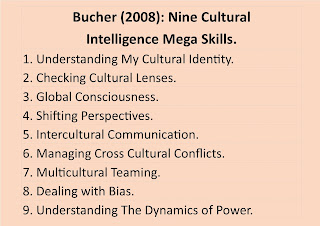INDIGENOUS KNOWLEDGE AND CULTURAL RESPONSIVENESS.
To understand indigenous knowledge, people need to accumulate their own personal understanding of ‘culture’. Yes, it is the characteristics of a group of people, their music, dance, food and art. However, it is so much more.
When applying the Mauri Model, I consider myself as sitting at the Mauri Ora level, the state of being actively engaged. My cultural framework is strong. I do not take on the perceptions of others, I have an open mind and develop my own understandings by being a listener and an observer.
Gay (2010) defines culturally responsive pedagogy as teaching ‘to and through students’ personal and cultural strengths, their intellectual capabilities, and their prior accomplishments’ (p. 26). I believe this is the case, the bottom line.
To be an effective cultural facilitator, you need to consider where you sit in relation to the Nine Cultural Intelligence Mega Skills, as identified by Bucher (2008). On reflection, I can check off numbers 1 to 8. A key contributing factor to where I am ‘at’ in terms of cultural intelligence, are the six years I spent teaching internationally and travelling extensively. This, along with learning a new language and being exposed to many different cultures and experiences contributed extensively to my sound cultural framework on which I sit culturally responsive pedagogy.
Our school considers the Kaupapa Māori principals and Ngai Tuwharetoa tikanga when practicing cultural responsive pedagogy. This approach is literally the understanding of making decisions in ‘a Māori way’. (Smith, 2004; Macfarlane, 2008). Mauri is considered the life force, “a central place in informing Māori, how and why our lives take the forms they do” (Pohatu, 2011, p.1).
I have also used the Mauri Model as the lens to review my school’s culturally responsive practices.
Learning Activities. We sit at the Mauri Ora level, the state of being motivated, engaged and committed. Our recent Wellness Survey gave direct feedback (from students) that our teachers try hard to create a context that is responsive to children and their cultures. This is evidenced in our School Schematic where we have a ‘take’ on our curriculum that open opportunities to be culturally responsive. As an example; this year’s Inquiry topics have been;
- Who are we? Kia Kaha. Team Taupo.
- Globalisation.
- Health – Identity, Sensitivity and Respect.
- Citizenship Inquiry.
- Land and People.
- Matariki.
These learning themes always culminate in a Learning Celebration, which our school community attends in force. School assemblies (and our newsletter) have a ‘country of the week’ with facts, pertinent photographs being shared and the National Anthem played. We fly a flag from a different country each day. Our foyer area shows a world map that indicates where our children originate from. Children for whom English is a second language are supported through specialist lessons. Our school notice board shows greetings in different languages. The Tuakana-Teina philosophy is strong and evident with senior and junior students interacting in many scenarios. Kapa Haka is a key part of the culture of our school. This year we had over 100 children attend the Tuwharetoa festival. Our school embraces relationship centred education. .
Our School’s Vision, Mission and Core Values. I feel we are sitting at Mauri Moe. This level is described as having woken and beginning to interact. Considering our vision, mission and core values, they could be more in line with cultural diversity component of The New Zealand Curriculum and possibly including phrases such as equity, diversity, and inclusivity to further promote culturally responsive relationship education.
REFERENCES
Bucher, R. (2008). Building Cultural Intelligence (CQ): Nine Megaskills. Upper Saddle River, NJ: Pearson Education Inc.
Bishop, R. Edtalks. (2012, September 23). A culturally responsive pedagogy of relations. [video file]. Retrieved from https://vimeo.com/49992994
Gay, G. (2010). Culturally responsive teaching (2nd ed.) New York: Teachers College Press.
Macfarlane, A. H., Glynn, T., Grace, W., Penetito, W., & Bateman, S. (2008). Indigenous epistemology in a national curriculum framework. Ethnicities, 8(1), 102-126.
Potahu, T. W. (2011). Mauri - Rethinking Human Wellbeing. MAI Review, 3, 1-12. Retrieved from http://www.review.mai.ac.nz/index.php/MR/article/viewFile/380/680
Smith, G. (2004). Kaupapa Māori Research – Katoa Ltd. Retrieved: http://www.katoa.net.nz/kaupapa-maori-evaluation
Teaching Tolerance. (2010, Jun 17). Introduction to Culturally Relevant Pedagogy [video file]. Retrieved from https://www.youtube.com/watch?v=nGTVjJuRaZ8



A high quality post, word count savvy and to the point. I like the succinct inclusion of all the things our school does as evidence for a culturally responsive pedagogy.
ReplyDeleteHi Janice. As I was going through the course material this week I was thinking of you and your experiences. You have surely had the most authentic culturally responsive experience of us all, having been totally immersed in the Thai culture. Your love and respect for the values, perspectives and language of the Thai people is obvious to all of us. I was lucky enough to have similar experiences when teaching Bengali and Somali students in East London, although I didn't live in their community as you did. Being invited into their homes to share the Eid celebrations was an honour I will never forget.
ReplyDeleteThanks for your thoughts Jenny. You are right in that my experiences are immeasurable and something that will be a part of me for ever (like your experiences too). Something to build culturally responsive pedagogy firmly on.
ReplyDelete